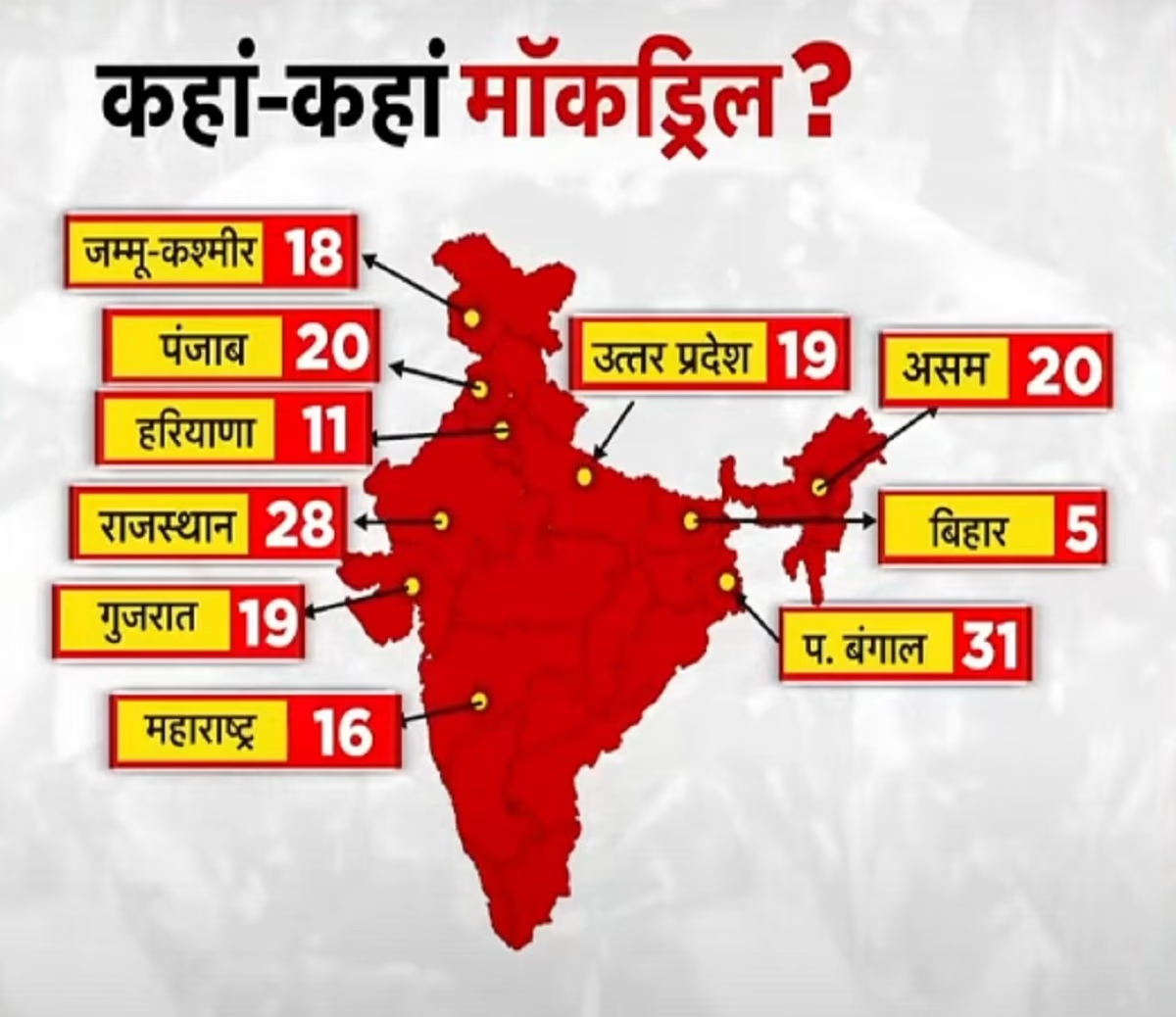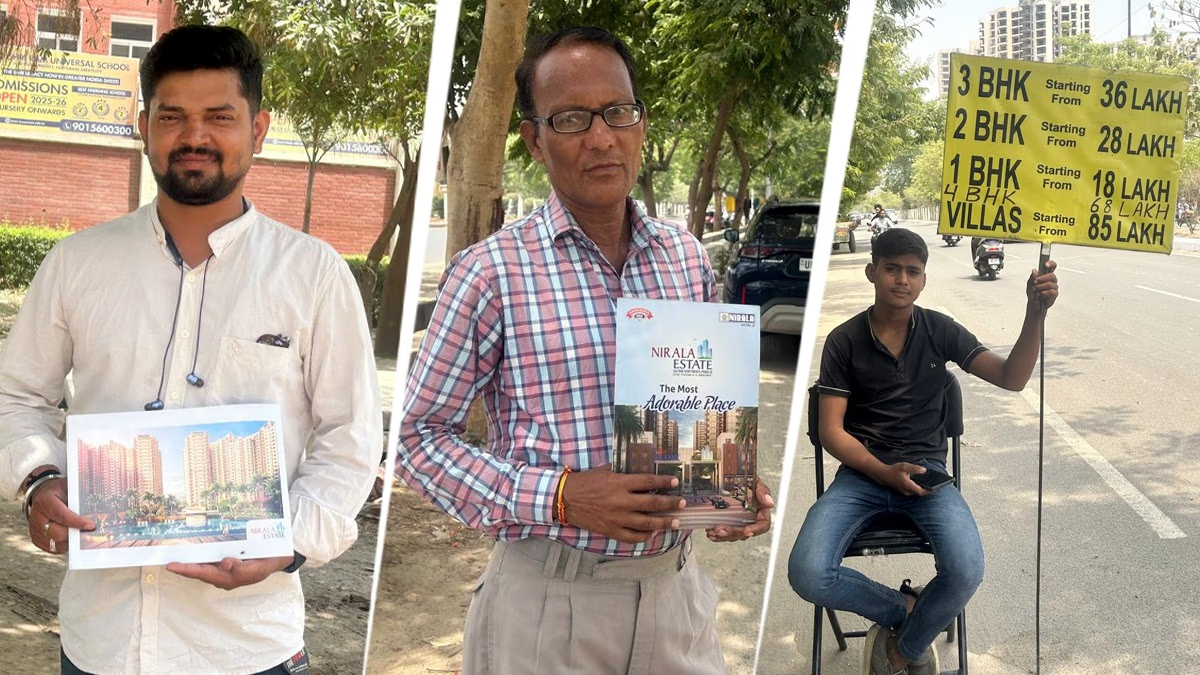Amidst escalating tensions between India and Pakistan following the Pahalgam attack, a mock drill will be conducted across 259 locations on Wednesday. Additionally, the Indian Air Force will conduct a war exercise along Pakistan's border on Wednesday and Thursday. Over the past 14 days, India has gradually prepared for this final stage against Pakistan, issuing NOTAMs for aerial exercises.
The Indian Air Force will practice in the desert area along the India-Pakistan border and surrounding regions. The exercise will feature multiple fighter jets, including Rafale, Mirage 2000, and Sukhoi-30. 'NOTAM' stands for 'Notice to Airmen,' providing immediate information regarding closed airspace, runway closures, or changes in lighting. The question arises: is this the final check to test our preparedness?
The trailer of the Civil Defense Mock Drill was visible in many cities across the nation on Tuesday. Many cities conducted blackout rehearsals, checking security arrangements. The 259 districts where the war siren will sound include districts and cities sharing a border with Pakistan, where essential defense facilities, power grids, ports, refineries, and other vital factories are located. Coastal districts from where enemy ships may launch attacks, and densely populated cities, where attacks could cause more damage, are also set for mock drills.
What is a Civil Defense Mock Drill?
A Civil Defense Mock Drill is an exercise simulating real-world conditions, including air raid sirens, city blackouts, and citizens being moved to safe shelters, while emergency teams play their roles. The goal is to increase citizens’ awareness and reduce panic, confusion, and damage during disasters.
Civil Defense districts are specially marked areas where management and training arrangements are made to ensure citizens' safety and assistance during disasters or war-like emergencies. In these districts, government systems, police, paramilitary forces, and civilian volunteers receive specialized training.

Source: aajtak
Five Tasks You Must Do During This Mock Drill-
1. Follow Administration's Instructions:
During the drill, fully comply with whatever instructions the local administration, police, or civil defense department provides. This helps avoid confusion and disorder. Follow the air raid siren closely.
2. Keep Essential Items Ready:
Have a small emergency kit on hand with a water bottle, necessary medications, a flashlight, a radio, and a mobile power bank. Keep cash readily available at home.
3. Stay Calm and Don't Panic:
This is merely a practice. Spreading fear or rumors can worsen the situation. Remaining calm and cooperative ensures your safety and that of others.
4. Avoid Rumors, Rely on Official Sources for Information:
Do not trust social media or unofficial sources. Focus solely on government websites, TV, radio, or administrative announcements for information.
5. Cooperate and Assist Others:
If there are elderly, children, or vulnerable individuals around you, assist them. Do not obstruct emergency services’ work, but cooperate instead.
Scheduled Timings and Locations for the Mock Drill
In Delhi, the drill will be conducted at 4 PM with air raid sirens, followed by a blackout exercise at 7 PM when all lights will be turned off. Ghaziabad will see civil defense mock drills in 10 schools, providing students with emergency safety information.
Mumbai's mock drill will commence at 4 PM, sounding 60 sirens across the city. A field in South Mumbai will serve as a gathering place where people learn survival tactics in wartime-like conditions. Considering the potential inconvenience of a complete blackout, the civil defense plans to execute it in a small suburban area.
Mock Drill Timings in Mizoram and Nagaland
Mizoram is set to host a comprehensive mock drill at 4 PM, educating citizens on emergency safety measures. Nagaland will see mock drills in 10 civic districts starting at 4 PM, involving local administration and citizen participation. A blackout from 7:00 PM to 7:10 PM will occur across various Bihar districts, simulating war lights situations.
In Patna, sirens will sound at 6:58 PM, followed by lights out after two minutes. Sirens will sound at 80 locations across the city. Lucknow and 19 other high-risk locations in Uttar Pradesh are marked for the mock drill.
Category-I: High Priority Locations
These locations are prioritized due to their national security, strategic significance, industrial centers, military bases, and economic activities. Port Blair in the Andaman and Nicobar Islands is prioritized for its strategic importance.
Visakhapatnam from Andhra Pradesh, a major port and naval base, is included. Arunachal Pradesh features Aalo (West Siang), Itanagar, and Tawang for their border and strategic sensitivity.
Assam includes multiple significant locations like Hayuling, Bongaigaon, Dibrugarh, Dhubri, Goalpara, Jorhat, Sivasagar, Tinsukia, Tezpur, Digboi, Duliajan, Guwahati (Dispur), Rangia, Namrup, Nazira, North Lakhimpur, and Numaligarh, vital for industrial, military, and geographical reasons.
Bihar's Barauni, Katihar, Patna, Purnia, and Begusarai are chosen for industrial and strategic importance. Chandigarh, a union territory and administrative capital, holds high priority.
The list includes Durg (Bhilai) from Chhattisgarh, a steel industry and industrial hub. Silvassa from Dadra & Nagar Haveli and Daman from Daman & Diu are listed for their special economic zones and industrial importance. Delhi, including New Delhi, is naturally prioritized as the nation's capital. North and South Goa (Panaji, Mormugao, Vasco, Dabolim) feature due to strategic naval bases and ports.
Ahmedabad, Surat, Vadodara, Kakrapar, Jamnagar, Gandhinagar, Bhavnagar, Kandla, Naliya, Ankleshwar, Okha, and Vadinar from Gujarat are included for their industrial, port, and nuclear significance.
Mock Drill in Haryana, J-K, Jharkhand regions
Haryana lists Ambala, Faridabad, Gurugram, Hisar, Panchkula, Panipat, Rohtak, Sirsa, Sonipat, and Yamunanagar for their links to industrial and military bases. Shimla in Himachal Pradesh, as the state capital, is included.
Jammu & Kashmir (including Ladakh) marks border and military significant districts like Anantnag, Pulwama, Budgam, Baramulla, Doda, Jammu, Kargil, Kathua, Kupwara, Leh, Poonch, Rajouri, Srinagar, Udhampur, Samba, Akhnoor, Uri, Naushehra, Sunderbani, and Awantipur.
Jharkhand includes Bokaro, Gomia, Jamshedpur, and Ranchi, important for industrial and strategic views. Karnataka features Bengaluru (Urban), Malleswaram, and Raichur for their leading IT and industrial roles. Kerala lists Kochi and Thiruvananthapuram where naval bases and administrative operations are centered.
Kavaratti in Lakshadweep is prioritized strategically. Madhya Pradesh features Bhopal, Gwalior, Indore, Jabalpur, and Katni as major administrative and industrial centers. Maharashtra lists Mumbai, Uran, Tarapur, Thane, Pune, Nashik, Rohan-Dhatat-Nagothane, Monmad, Sinnar, Thal-Vashot, Pimpri-Chinchwad as prominent urban and industrial hubs.
Manipur lists Imphal, Churachandpur, Ukhrul, Moreh, Ningthoukhong for their border and strategic importance. Meghalaya includes Shillong, Jowai, and Tura as strategic and tribal-sensitive areas.
Mizoram features Aizawl, and Nagaland lists Dimapur, Kohima, Mokokchung, Mon, Phek, Tuensang, Wokha, Zunhheboto, Kiphire, Peren as border districts. Odisha lists Talcher, Hirakund, Paradip, Rourkela, Balasore, Koraput, Bhubaneswar, Gopalpur as critical industrial and port areas. Puducherry is also prioritized for administrative and strategic views.
Identified Regions in Punjab, Rajasthan, Bengal
Punjab lists Amritsar, Bhatinda, Firozpur, Gurdaspur, Rupnagar, Sangrur, Hoshiarpur, Jalandhar, Ludhiana, Patiala, Pathankot, Adampur, Barnala, Bhakra-Nangal, Halwara, Kotkapura, Batala, Mohali, Abohar, Faridkot, known for defense and industries.
Rajasthan features Ajmer, Alwar, Barmer, Bharatpur, Bikaner, Bundi, Ganganagar, Phulera, Nagaur, Jalore, Beawar, Hanumangarh, Jaipur, Lalgarh, Jaisalmer, Sawai Madhopur, Jodhpur, Udaipur, Sikar, Nal, Suratgarh, Abu Road, Nasirabad, Bhiwadi, Pali, Bhilwara, Kota, Rawatbhata for military, industrial, or border significance.
Sikkim lists Gangtok, Tamil Nadu lists Chennai and Kalpakkam, Telangana lists Hyderabad, Tripura lists Agartala, Uttar Pradesh lists Bulandshahr (Narora), Agra, Allahabad, Bareilly, Ghaziabad, Gorakhpur, Jhansi, Kanpur, Lucknow, Mathura, Meerut, Moradabad, Saharanpur, Varanasi, Bakshi ka Talab, Mughalsarai, Sarsawa, Bagpat, Muzaffarnagar.
Uttarakhand features Dehradun, and West Bengal lists Cooch Behar, Darjeeling, Jalpaiguri, Malda, Siliguri, Kolkata, Durgapur, Haldia, Hashimara, Kharagpur, Burnpur-Asansol, Farakka-Khejuri, Chittaranjan, Balurghat, Alipurduar, Raiganj, Islampur, Dinhata, Mekhliganj, Mathabhanga, Kalimpong, Jal Dhaka, Kurseong, Kolaghat, Bardwan, Birbhum, Medinipur, Howrah, Hooghly, Murshidabad for diverse priorities.
Category-II: Medium Priority Locations
These locations are relatively less sensitive but cannot be ignored due to their strategic, social, or industrial importance.
Assam lists Darrang, Golaghat, Karbi Anglong, Kokrajhar. Gujarat lists Bharuch, Dangs, Kutch, Mehsana, Narmada, Navsari. Haryana lists Jhajjar, Jharkhand lists Godda, Sahibganj. Maharashtra lists Aurangabad, Bhusawal, Raigad, Ratnagiri, Sindhudurg. Odisha lists Bhadrak, Dhenkanal, Jagatsinghpur, Kendrapara as medium priorities.
Category-III: Low Priority Locations
This category is for regions considered relatively low risk. Arunachal Pradesh lists Bondila as low priority, which is geographically a border area but not deemed highly sensitive at present.




